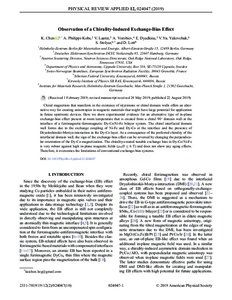Observation of a Chirality-Induced Exchange-Bias Effect
Скачать файл:
Автор:
Chen, K.
Philippi-Kobs, A.
Lauter, V.
Vorobiev, A.
Dyadkina, E.
Yakovchuk V. Yu.)
Stolyar, S.
Lott, D.
Коллективный автор:
Научно-исследовательская часть
Дата:
2019-08Журнал:
PHYSICAL REVIEW APPLIEDКвартиль журнала в Scopus:
Q1Квартиль журнала в Web of Science:
Q1Библиографическое описание:
Chen, K. Observation of a Chirality-Induced Exchange-Bias Effect [Текст] / K. Chen, A. Philippi-Kobs, V. Lauter, A. Vorobiev, E. Dyadkina, Yakovchuk V. Yu.), S. Stolyar, D. Lott // PHYSICAL REVIEW APPLIED. — 2019. — Т. 12 (№ 2).Аннотация:
Chiral magnetism that manifests in the existence of skyrmions or chiral domain walls offers an alternative way for creating anisotropies in magnetic materials that might have large potential for application in future spintronic devices. Here we show experimental evidence for an alternative type of in-plane exchange-bias effect present at room temperature that is created from a chiral 90 degrees domain wall at the interface of a ferrimagnetic-ferromagnetic Dy-Co/Ni-Fe bilayer system. The chiral interfacial domain wall forms due to the exchange coupling of Ni-Fe and Dy-Co at the interface and the presence of Dzyaloshinskii-Moriya interaction in the Dy-Co layer. As a consequence of the preferred chirality of the interfacial domain wall, the sign of the exchange-bias effect can be reversed by changing the perpendicular orientation of the Dy-Co magnetization. The chirality-created tunable exchange bias in Dy-Co/Ni-Fe is very robust against high in-plane magnetic fields (mu H-0 <= 6 T) and does not show any aging effects. Therefore, it overcomes the limitations of conventional exchange-bias systems.

